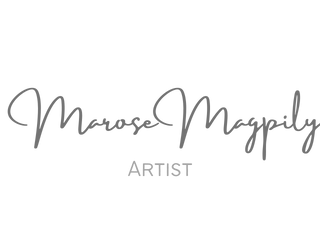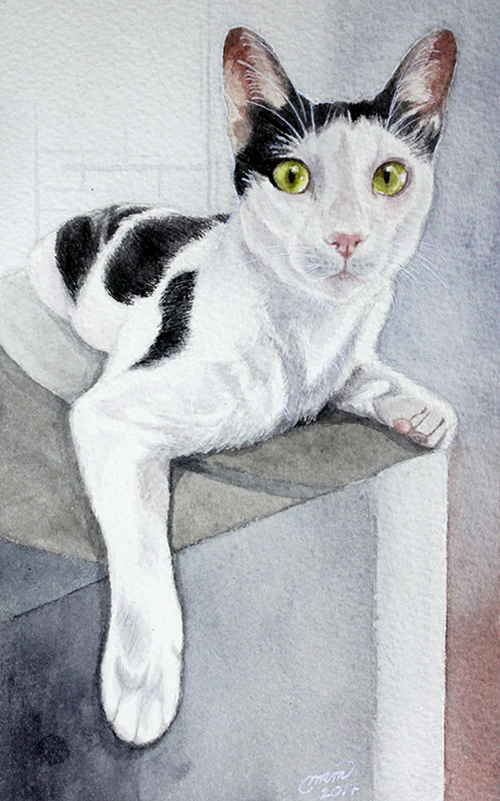This is a review of all the materials I used for my 30-Day Watercolor Challenge
PAINT: Pentel Watercolors, 14 Color Set
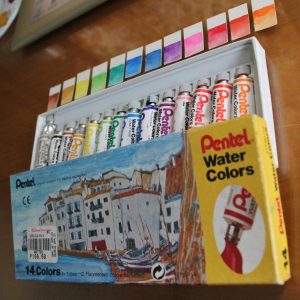 This is a watercolor set that I bought so many years ago at 166.50PHP (roughly 3.00USD) from National Bookstore. I don’t even remember when. Sadly they were left forgotten in one of my drawers. I was happy to discover that years of storage had preserved them for use, and when inspiration struck they were available and ready to serve my creativity.
This is a watercolor set that I bought so many years ago at 166.50PHP (roughly 3.00USD) from National Bookstore. I don’t even remember when. Sadly they were left forgotten in one of my drawers. I was happy to discover that years of storage had preserved them for use, and when inspiration struck they were available and ready to serve my creativity.
At that point, and being basically a newbie to watercolor painting, I couldn’t compare the quality of Pentel colors to any other paints and so could not be disappointed while I was using them.
You can do quite a lot with them and the colors, though a bit lacking in vibrancy, are not that bad.
I think the brown and green hues are the ones I used the most and that produced the best paintings.
Didn’t know to make a mixing chart then, which might have made it easier to find the color mixes that I needed. But, though it took quite a lot of experimentation, I was able to reproduce most of the colors that I saw in reference photos with the colors available in this set.
Comparing it to paintings produced by other artists with artist grade paints, you will see an obvious difference: Pentel paint on paper is quite granular and, like I’ve said, not as vibrant. The wrong kind of paper will also amplify this shortcoming even more, I believe.
Also, the tube paints dry very quickly once out of the tube, and it takes quite a lot of water to revitalize them again.
Conclusion: Pentel Watercolors are suitable for the student or newbie watercolor artist and will take you a long way even as your skills develop. If you just want to try out watercolor painting without spending too much on paints just yet, I’d say, these paints will serve you well as they did me.
BRUSHES
Hidden away with my Pentel Watercolor set were quite a number of old watercolor brushes. Some had too much wear on them that they would be good only for mixing paints. But there were a few round brushes and flat brushes that were still good.
The brushes that I used the most were an old No.3 and a No.5 round brush. Unfortunately, they are so old, that the brand can no longer be read on the wooden grip, so I cannot say who made these great and durable brushes. But I can make out that they were made from weasel hair.
The No.3 could be shaped into a fine enough point when wet that I was able to paint the details on this shell without needing a smaller brush:
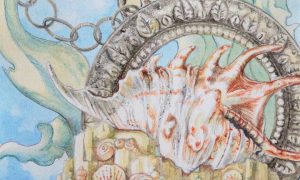 These two brushes alone were so useful that I didn’t feel the need to buy any new brushes for a long while until I tried out painting botanicals and portraits with fine details in the eyes and lips.
These two brushes alone were so useful that I didn’t feel the need to buy any new brushes for a long while until I tried out painting botanicals and portraits with fine details in the eyes and lips.
At Deovir Art Supplies, I bought myself a set of Royal & Langnickel sable brushes. They get the job done especially for the details. But I would also want to buy some stiffer nylon hair brushes.
In hindsight, buying sable hair watercolor brushes was hasty and irresponsible of me. I feel that I should have done more research about brush production and if the animal hair is acquired humanely. I googled it later, but haven’t found any satisfactory answers to this yet.
MIXING PLATE / PALETTE:
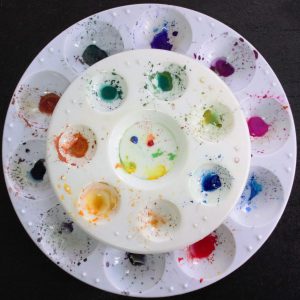 Nothing fancy here. I just used a regular old plastic mixing palette that I think I’ve had since grade school. It’s so well used and has been washed so many times that the surface has become rough and the paint remains in place instead of beading up, which you might experience with some newer plastic palettes that still have smooth surfaces.
Nothing fancy here. I just used a regular old plastic mixing palette that I think I’ve had since grade school. It’s so well used and has been washed so many times that the surface has become rough and the paint remains in place instead of beading up, which you might experience with some newer plastic palettes that still have smooth surfaces.
Because I don’t wash paints in my palette out immediately, in case I will be using the same colors or color mixes in another painting, I decided to buy another bigger plastic plate so I could mix more colors while keeping the leftover ones.
Conclusion: When using plastic palettes for mixing, worn is better. If you still have a good amount of paint left over, don’t wash it out just yet. The paint will dry in the pan or in the well and you can revitalize it with water for later use.
PAPER:
For paper I tried 3 different kinds:
Bevania Splendorgel Board, White 160gsm
This was the first paper I painted on. Knowing little about watercolor painting at the time, I knew only that I needed to use a thicker kind of paper to absorb the water I was going to use. So I picked what was at hand and went with the Bevania Board.
Of course, the paper warped as I continued to paint, but since I wasn’t doing any heavy washes it sufficed. With a bit more research, I learned about paper stretching and actually attempted it with this paper, soaking an entire sheet in water, only to discover that the soaking thinned the surface too much, making it useless for painting.
Conclusion: You can only get away with painting on non-watercolor paper for paintings that involve very little to no washes. The paper will warp, no matter what, but it will still dry flat, especially if you compress it between some heavy materials like books.
This one was done on Bevania Board: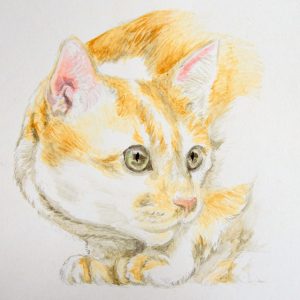
Fabriano Artistico Hot Pressed, 100% Cotton, White 300gsm
Since I wanted to practice a variety of watercolor painting techniques including washes, I knew I had to get myself something better than the Bevania board I had at home.
On my next trip to National Bookstore, I discovered a stack of large 22x30cm Fabriano Artistico watercolor paper sheets and decided to get one. Being one of the higher quality watercolor papers, it is quite expensive and one sheet costs somewhere around 400PHP. Still, I preferred this to the 180gsm watercolor sketchpads that were available because I wanted something heavier and I wanted something that I could cut down to small custom sizes. Fabriano Artistico pads were also available, but they were just too expensive for me, especially considering I was just a beginner looking to practice.
I expected the paper to feel smooth to the touch, but I was surprised to find it felt grainy and powdery, with some residue coming off when I would brush my fingers across it. I’m not sure if this is standard for this kind of paper.
I folded the paper in half and used one half to make small postcard sized sheets for use to practice. For the first few paintings I did on this paper, I didn’t bother with stretching it beforehand. 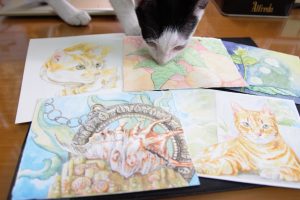 The paper would still warp but not as much, and it did not thin down even with multiple layers of paint and washes.
The paper would still warp but not as much, and it did not thin down even with multiple layers of paint and washes.
I was able to flatten unstretched paper after painting by lightly misting the back surface with water and then compressing it for a few hours in between some heavy books.
I did find that washes were still challenging to carry out successfully. This may be a problem with the lower grade Pentel paint I was using, which seemed grainy, and it settled and dried quickly.
For my next practice pieces, I took the time to stretch the paper first. I did this on a plastic clipboard that I had and using ordinary office masking tape.
Paper stretching is done by soaking the entire sheet in water, then taping it down with masking or painter’s tape. Leave the paper to dry overnight and it will be ready for you to paint on the next day. When you are done with your painting, gently peel off the tape. The edges of your painting will be nice and clean.
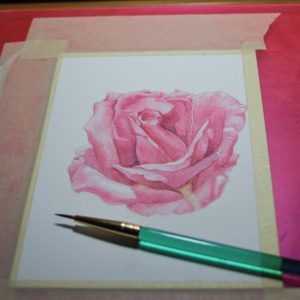
Conclusion: This is the only heavy paper I’ve bought so far. As expected, it holds water well, withstands washes, and will not warp too much even if you don’t stretch it, and you can still flatten the paper afterwards if you wish. But if you take the time to stretch your paper, the nice margins created when you pull the tape off will give your painting a nice finished look and will leave you feeling very satisfied.
Additional note: I’ve been using Fabriano for some time now and have found that you don’t actually need to stretch the paper. Just tape it down before use and you’re good to go.
Berkeley Watercolor Pad, 180gsm
Because I wanted to try making a custom-sized watercolor sketchbook, I later on bought myself a 270mm x 380mm Berkely Watercolor Pad with 24 sheets in it. I tore out 12 sheets, cut these in half, and folded these in half again and used them to make 3 signatures (4 sheets or 16 pages per signature) for a text block. I bound the text block using coptic stitch binding. Illustration board covered with colored construction paper served for the cover.
https://www.instagram.com/p/BHa55X2BqT3/?taken-by=marosemagpily
Later, I discovered that I actually already had a smaller 190mm x 270mm unused Berkeley pad stashed away with old notebooks and other sketchbooks. Some of the pages had stains and mold on them. I just tore them out so they would not contaminate the clean pages that were left.
I ended up doing most of my experimentation and practice work on the thinner Berkeley pad after all.
Conclusion: Berkeley is also good for practice, but you won’t be able to do too many heavy washes before thinning and destroying the paper. The paper is cold-pressed, so it’s very rough. Even a 2H pencil, leaves dark marks on it. Ink lines are also very difficult to control because of the roughness. Lastly, and I’m not sure if this is true for most watercolor papers, there is a wrong side to paint on when using Berkeley paper. The rough side is good for several paint layers and a couple of washes, but painting on the wrong side -the side that looks smoother – is generally only good for detail paintings or techniques that utilize only a little water.
TO SUM IT ALL UP
If you are just starting out with watercolor painting, student grade watercolor sets like those produced by Pentel are good enough to get you started, and you will already be able to practice a lot of technique. I’m glad I held off on buying artist grade paints and decided to begin my watercolor journey by painting with the student set that I already had. Now that I’ve had a taste of using artist grade Holbein paint, I can really appreciate the higher quality and the distinct difference over student grade paint.
For my 30-day watercolor challenge, because I chose to use a student paint set, my biggest spend was just on Fabriano Artistico watercolor paper. But it was a good investment because with just one large sheet I was able to practice a whole lot and there is still plenty of that one sheet that I bought still left over. The cheaper Berkeley watercolor paper is also good for practice painting and doing studies.
I definitely learned so much from this exercise, and I hope that sharing this review has been helpful to you as well!
